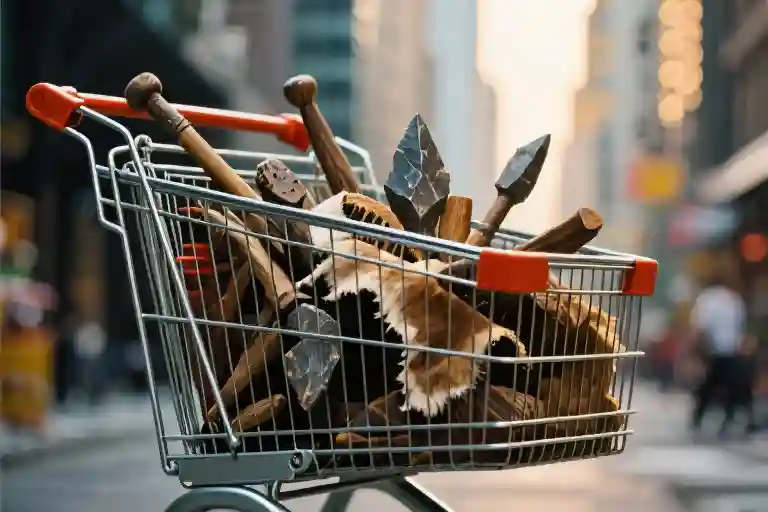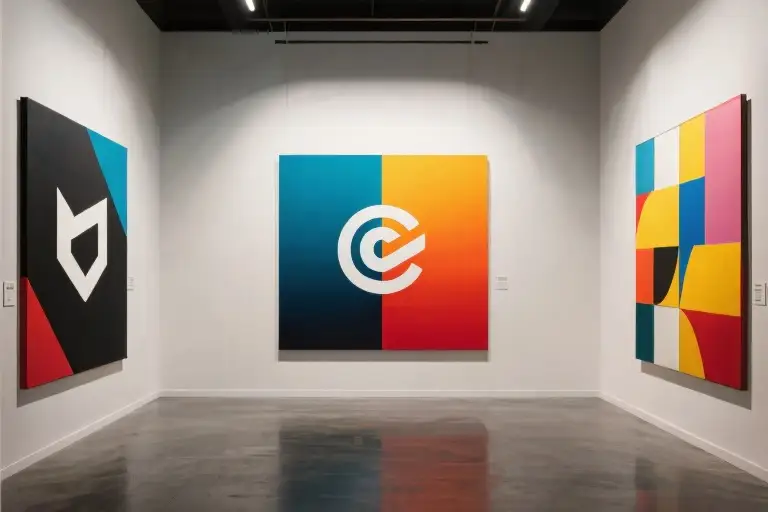The first trade happened under a paleolithic sky. One caveman clutched a sharpened flint, another held a stack of animal hides. No contracts, no marketing funnels—just raw human need meeting opportunity. Fast forward 50,000 years, and you’ll find the same biological wiring firing as someone clicks ‘Buy Now’ during a 2am Instagram scroll.
Our prefrontal cortex may have upgraded, but the operating system remains Stone Age 1.0. That impulse driving your Amazon Prime addiction? It’s the same neural pathway that made our ancestors chase woolly mammoths across tundras. Modern commerce didn’t invent new desires—it simply repackaged ancient cravings in glossy wrapping.
Consider bottled water—a $300 billion industry selling what flows freely from taps. The product isn’t hydration, but the promise of purity, status, and survival assurance. These are the same psychological levers that once motivated cave paintings of fertile animals. From Lascaux to Las Vegas, we’ve always paid premium for symbols addressing primal fears.
The most profitable business models aren’t inventions, but rediscoveries. Amazon didn’t create the marketplace—they digitized the ancient bazaar. Tinder didn’t invent attraction—they optimized the mating dance. The trillion-dollar question isn’t ‘What’s next?’ but ‘What’s always been true?’
Neuroscience reveals our purchasing decisions take 2.5 seconds—exactly how long early humans had to assess threats. That adrenaline surge when limited-time offers appear? It’s your amygdala reacting like it’s spotted the last berry bush before winter. We’re not rational actors but emotional survivors, making 21st century choices with paleolithic programming.
Three eternal drivers emerge across anthropological studies:
- Survival shortcuts (from firewood subscriptions to meal kits)
- Reproduction signaling (Luxury watches as peacock feathers 2.0)
- Tribe validation (Social media likes triggering the same dopamine as grooming primates)
The pattern holds across civilizations. Babylonian merchants sold fertility amulets where modern influencers peddle ‘manifestation crystals.’ Roman bathhouses offered social climbing opportunities now found in coworking spaces. The tools change; the game stays the same.
Successful businesses don’t fight this reality—they speak its language. Notice how:
- Dating apps use the same variable reward system as slot machines (and hunter-gatherer foraging)
- Fitness brands sell not exercise, but mating competitiveness
- Productivity tools market themselves as ‘alpha status’ enablers
Your greatest business advantage isn’t predicting trends, but recognizing which human needs are trend-proof. While tech evolves, the profit formula remains: identify persistent desire + reduce friction + collect your middleman toll. The rest is commentary.
Next time you evaluate an opportunity, ask the caveman test: Would this have value to someone wearing animal skins? If yes, you’ve likely found something more durable than any fleeting market craze. Because beneath our suits and smartphones, we’re all still trading shiny rocks—we just call them NFTs now.
The DNA of Desire
Our brains are running on software that hasn’t received a major update in 50,000 years. That prehistoric operating system still governs every financial decision we make today – from choosing a breakfast cereal to investing in startups. The same neural pathways that lit up when our ancestors found ripe fruit now activate when we see limited-time offers.
The Three Eternal Wants
Every profitable business in history taps into at least one of these hardwired human cravings:
- Survival Shortcuts (The Lazy Brain’s Bargain)
From pre-cut vegetables to robot vacuums, we’ll pay premium prices to conserve calories. The $72 billion meal kit industry proves our stone-age brains still prioritize energy preservation over wallet preservation. - Reproduction Rewards (Biology’s Blind Spot)
Dating apps didn’t invent loneliness – they simply digitized the village matchmaker. Modern platforms generate $5.6 billion annually by monetizing the same primal urge that once inspired cave paintings of fertility symbols. - Tribe Tokens (Social Currency Minting)
That $8 artisanal toast isn’t about nutrition – it’s a bronze-age status signal wearing Instagrammable packaging. Harvard researchers found people will pay 47% more for identical products when they convey group belonging.
Ancient Desires, Modern Wrappers
Consider these evolutionary echoes in today’s marketplace:
- Fire → Netflix
Our ancestors gathered around flames for warmth and stories. Now we pay monthly subscriptions for the same communal dopamine hit, just with better special effects. - Shaman → Life Coach
Prehistoric tribes traded goods for spiritual guidance. The $1.5 billion coaching industry offers the same promise of transformation – with nicer office chairs. - Cave Paintings → LinkedIn
Early humans marked territory with symbolic art. Professionals now craft personal brands with carefully curated post histories and skill endorsements.
The most successful companies understand this truth: human nature upgrades slower than technology. While our tools have evolved from stone axes to smartphones, the psychological levers that drive purchasing decisions remain unchanged.
Next time you evaluate a business opportunity, ask yourself: which ancient human desire does this serve? The answer will predict its longevity better than any market trend analysis.
Profit Choke Points: The Invisible Handshake of Commerce
Money flows where friction exists. This isn’t some modern economic theory—it’s the unwritten law of every marketplace from ancient bazaars to digital storefronts. The most profitable positions in any economy have always been the choke points where desire meets distribution.
The Middleman Equation
Every sustainable middleman business operates on a simple formula:
Profit = (Demand Intensity × Information Asymmetry) / Transaction FrictionLet’s break this down with examples you interact with daily:
- Demand Intensity:
- The 24-hour urgency of UberEats (hunger)
- The nervous excitement before a first date (Tinder Boost purchases)
- The panic of a missed deadline (FedEx overnight shipping)
- Information Asymmetry:
- Car dealerships knowing the true invoice price
- Realtors with off-market property knowledge
- Amazon sellers spotting trending products before competitors
- Transaction Friction:
- Airbnb reducing the risk of stranger stays
- PayPal simplifying cross-border payments
- Carvana removing dealership haggling
The sweet spot? High desire, limited transparency, and painful alternatives. This explains why:
- Wedding planners charge 20% premiums (emotional demand + complex logistics)
- Pharmaceutical distributors thrive (regulated information + life-or-death needs)
- Crypto exchanges print money during bull runs (FOMO + technical barriers)
Ethical Arbitrage: The Thin Line
There’s an important distinction between value-adding intermediaries and parasitic middlemen. The test? Ask:
- Does your involvement reduce the end user’s total cost or hassle?
- Good: Ticketmaster providing fraud protection and centralized inventory
- Bad: Scalper bots creating artificial scarcity
- Are you revealing hidden value or creating artificial barriers?
- Good: Consumer Reports testing products objectively
- Bad: Extended warranty pushers exploiting fear
Modern platforms walk this tightrope daily. Consider:
- eBay’s evolution: Started as a pure peer-to-peer marketplace, now monetizes through:
- Promoted listings (paying to reduce friction)
- Authentication services (adding trust layers)
- Managed payments (simplifying transactions)
- OnlyFans’ duality: Simultaneously:
- Empowers creators to bypass traditional industry gatekeepers
- Takes 20% cut for providing payment processing and content hosting
The most sustainable middlemen position themselves as lubricants rather than roadblocks in the transaction chain.
Platform Alchemy: Turning Friction Into Gold
Every successful platform business is essentially a friction-removal machine with toll booths strategically placed at pain points. Here’s how they engineer profitability:
1. The Trust Bridge
- Before: Strangers hesitated to stay in each other’s homes
- After: Airbnb’s review system and insurance created trust
- Profit Point: 14-20% service fee
2. The Convenience Tax
- Before: Finding reliable local services required word-of-mouth
- After: Angi (formerly Angie’s List) standardized and guaranteed providers
- Profit Point: $10-50 per lead
3. The Access Premium
- Before: Niche products had limited distribution channels
- After: Etsy connected makers with global buyers
- Profit Point: 6.5% transaction fee + payment processing
The pattern? Identify where lack of trust, discovery, or standardization is preventing transactions, then build the thinnest possible layer that solves just that problem.
The Middleman’s Dilemma
All intermediary positions face the same existential threat: disintermediation. Smart operators future-proof their choke points by:
- Owning the data (Zillow’s home value estimates)
- Controlling the identity layer (Facebook Login)
- Becoming the quality standard (Michelin Stars for restaurants)
- Embedding financial services (Shop Pay installments)
The most bulletproof middlemen make themselves invisible—you don’t think about Visa when swiping a card, yet they take a cut of every transaction.
Your Move
Spotting profit choke points requires training yourself to see economic transactions as systems. Next time you:
- Wait too long for a restaurant reservation
- Struggle to compare insurance policies
- Feel uncertain about a Craigslist seller
…you’re staring at a potential middleman opportunity. The question isn’t whether the position exists—it’s whether you can add enough value to justify your toll.
The Caveman’s MBA: Mining Timeless Desires
Money flows where desire runs deepest. The most successful entrepreneurs aren’t those chasing the latest tech trends, but those who’ve mastered reading humanity’s oldest operating manual. Here’s how to conduct your own excavation of perpetual profit streams.
The 5-Layer Desire Filter
Modern markets are archaeology sites where primitive instincts wear digital disguises. To uncover them:
- Surface Complaints → “I need faster delivery”
- Emotional Drivers → “I feel embarrassed when packages arrive late”
- Social Signals → “My neighbors judge me by delivery frequency”
- Survival Imprints → “Resource abundance signals tribal status”
- Genetic Hardwiring → “Mate selection favors reliable provisioners”
Amazon Prime’s success becomes obvious when you trace it back to Pleistocene mating strategies. Their 2-day shipping taps into the same neural pathways that once valued hunters who could consistently provide.
3 Validation Experiments That Don’t Lie
Forget focus groups. These field tests reveal true willingness-to-pay:
- The Abstinence Test
Remove the product/service for 30 days. Do users:
- Beg for its return (strong desire)
- Create DIY alternatives (moderate)
- Forget it existed (abandon)
- The Pain Threshold
Gradually increase price until 20% attrition occurs. The optimal price point sits just below where complaints outweigh purchases. - The Tribal Mimicry
Seed the product within tight-knit communities (churches, sports teams). Genuine desires spread organically through trusted networks.
Why Web3’s Middleman Rebellion Failed
The decentralized revolution misunderstood human nature. While blockchain eliminated financial intermediaries, it ignored three primal realities:
- Cognitive Laziness: Most prefer centralized trust over verifying every transaction
- Status Hunger: NFTs succeeded by recreating tribal prestige markers, not through utility
- Risk Aversion: The 51% attack paradox proves we’ll always pay for security assurances
Successful modern middlemen like Airbnb thrive by enhancing (not removing) trust mechanisms – verified photos, standardized ratings, and guaranteed dispute resolution. The winning formula adds frictionless value atop existing desires, never attempting to rewire human firmware.
Your Stone Age Toolkit
- Carry a “desire journal” to record overheard frustrations (modern cave paintings)
- Map every purchase decision to Maslow’s hierarchy with a color code
- Study historical black markets – they reveal unfiltered demand
The next billion-dollar idea won’t be found in a tech incubator, but in the same impulses that made someone trade two goats for a sharper flint axe. Your competitive edge? Recognizing that the axe is now a smartphone, but the desperation for it remains unchanged.
Your Next Stone Age Tool Is Waiting
The same instincts that made a caveman trade his best flint knife for ochre body paint now make you click “Buy Now” at 2 AM. That impulse hasn’t evolved – only the marketplace did.
The Ultimate Callback
Remember our opening scene? The shiny rock exchanged for a sharper spear wasn’t just prehistoric barter. It was the first recorded instance of:
- Desire recognition (status display through pigments)
- Friction reduction (specialized tool creation)
- Value arbitrage (unequal labor time exchange)
Modern translation: Someone sold Instagram filters to a guy with mediocre photos.
Your 3-Part Survival Kit
- The Middleman’s Field Guide (Downloadable PDF)
- 7 question flowchart to identify profitable gaps in any industry
- Commission structure calculator for 12 common intermediary models
- Red flag checklist for unsustainable demand (avoids Web3 mistakes)
- Desire Decoder Workshop (30-min Video)
- How to “interview” customers without asking direct questions
- Body language tells for unstated needs (works for Zoom calls too)
- The 5-word rebranding trick that connects features to primal urges
- Caveman MBA Case Studies
- How a pet rock seller out-earned tech startups in 1975
- Why OnlyFans creators use the same pricing psychology as Roman bathhouses
- TikTok live sales vs. medieval market criers: A side-by-side breakdown
The Circle Closes
That smooth stone your ancestor held? It’s now:
- The smartphone case protecting social connection
- The ergonomic mouse enabling productivity
- The wedding band symbolizing reproductive partnership
The materials changed. The market forces didn’t. Your advantage? You now see the invisible threads tying every successful transaction back to those three original needs: survival, reproduction, social standing.
Action Drill: Open your notes app right now and answer:
- What’s the “shiny rock” in my industry? (Hint: It’s usually what people collect but rarely use)
- Who’s still crafting “flint spears” manually? (These are your ideal suppliers)
- Where’s the muddiest path between them? (That’s your tollbooth location)
When you spot the pattern, you’ll start seeing Stone Age opportunities in every “modern” business struggle. The code was never hidden – we just painted over it with buzzwords.





